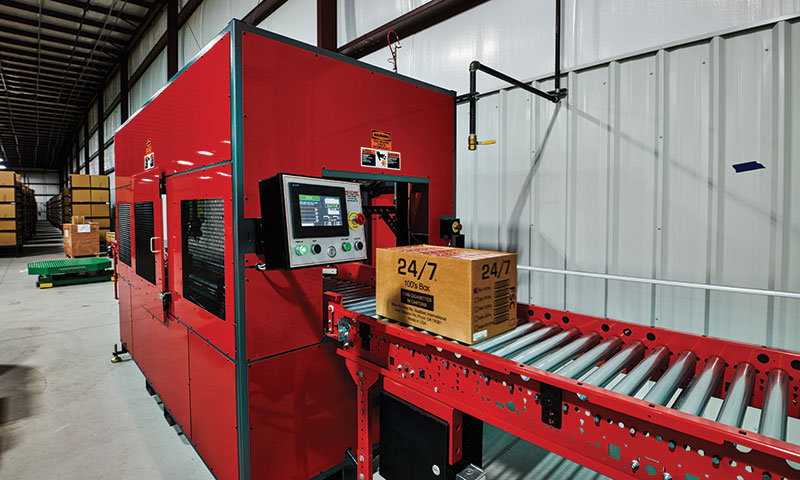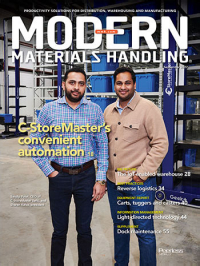C-StoreMaster’s convenient automation
C-StoreMaster is bringing a new level of robotics and automation to convenience store replenishment.
Over the years, we’ve covered a number of industries with unique distribution models, including wine and spirits, freshwater fishing tackle, door hardware and firearms. While they seem diverse, they share a few commonalities.
For one, they are industries that have historically been made up of small, regional distributors, but are in the process of consolidating. That consolidation has generally been led by an innovator that offered new services empowered by automation. For another, the distributors have to serve large customers with a national footprint and small, mom-and-pop stores alike. And, they often deal in specialized inventory, including highly regulated products that require special handling and compliance with government regulations, as is the case in firearms and alcoholic beverages.
Let’s add convenience store distribution and replenishment to that list of industries, and C-StoreMaster, a distributor based in Huntsville, Ala., to the list of companies innovating in the space. What’s more, tobacco, one of the most highly regulated products on the market, is among the products the company distributes. To keep up with exponential growth, the family-owned company recently opened a new 135,000-square-foot distribution center powered by autonomous mobile robots (Geek+) in Huntsville, Ala.
The facility is an illustration of what Gartner analyst Dwight Klappich has dubbed heterogenous robotics. While all of the robots are from Geek+, C-StoreMaster is currently using three different autonomous mobile robot (AMR) platforms: One handles pallets; one moves shelving that provides high-density storage for totes, much like the former Kiva system; and one can store and retrieve totes from high-density shelving that reaches to 15 feet. While no decision has been made, C-StoreMaster is considering autonomous lift trucks in the future.
“This is a passion project for our company,” says Sharan Kalva, president. “Huntsville has always had low unemployment, so the current labor shortage isn’t new to us. As a family-owned business, we emphasize the importance of our employees, and one way to demonstrate that commitment was to build a facility with the best work environment for our team members: One that is ergonomic, air conditioned and comfortable. That’s how this project got started.”

The company wanted to create as simple, lean and efficient operation as possible to handle steady growth now and in the future. “The robots manage about 80% of the work and inventory is touched just three times by team members,” says Kalva. “Once when it’s manually unloaded from inbound trucks, once when it’s picked and once again when orders are consolidated for shipping.”
Thirty years of growth
According to Kalva, C-StoreMaster’s roots extend back some 17 years, when his father opened the first of what became 50 convenience stores collectively with his partner.
At the time, says Kalva, “they didn’t have a good distributor.” Typically in a region, you had a large primary distributor with a national footprint and a lot of smaller mom-and-pop distributors. “The large distributors weren’t flexible and the small distributors weren’t efficient,” Kalva says.
His father Satish Kalva, the company chairman, and Sandip Patel, the CEO, launched C-StoreMaster in 2015 with the idea that there ought to be a distributor that could consolidate all of the SKUs sold in a convenience store and “do it right,” says Kalva. “They launched the company to serve their 50 stores and 50 of their friends and family rather than to turn a profit.”
Kalva, 28, has an industrial engineering and supply chain degree from Auburn University and worked for a leading medical devices manufacturer before joining the family business.
It turned out they were onto something. Within a few years, they were serving 800 stores from 6,000 square feet of space in a strip plaza. Growth came by word of mouth. A new customer with a few stores would refer the pair to a relative or friend who also had a few stores, and so on. “There was no marketing; it was all word of mouth,” says Kalva.
Four years ago, the company built a 35,000-square-foot facility. In addition, it operated a small satellite facility in eastern Tennessee and in Montgomery, Ala. In short order, the 800 stores had expanded to more than 1,000, and the company was operating at capacity, while using containers in the yard for extra storage.

Today, the company is shipping to more than 4,000 independent convenience stores and 6,000 chain stores in 26 states, including more than 3,000 Circle K locations. It manages 5,000 SKUs, including general merchandise, non-alcoholic beverages and tobacco products, and in-stock availability for more than 99.9% of products. Most orders are delivered on a next-day basis. The new facility is designed to pick 200,000 lines per day.
When the plans were created for the new facility, a top goal was to consolidate inventory and do picking from one location that would be co-located with planning and sales. The Montgomery and Tennessee facilities become the equivalent of crossdock facilities, where shipments could be broken down into orders for local delivery.
“To do that, we asked: How can we build one singular warehouse, with accurate inventory, high levels of in-stock availability and very efficient picking?” says Kalva. “Efficiency is our competitive advantage.”
AMRs proved to be the answer. They are responsible for the movement of pallets once they have been manually unloaded and processed in receiving right into outbound trucks on the receiving dock, including putaway and retrieval into storage. They also move product that has been depalletized, placed into totes and stored on shelves moved by robots and totes of cigarettes that have been processed in batches by states until they’re ready for order consolidation.
Indeed, other than the customer relationship management (CRM) system and warehouse management system (WMS), which were developed in house, manual lift trucks, the stretchwrapper and some packing equipment, all of the equipment and technology in the facility is part of the robotics system.


“If you’re a fast-growing company, a typical fixed infrastructure process is a risk. There’s not a lot of adaptability,” says Kalva. “We wanted a customizable and open-ended system. If for some reason the current design doesn’t work, we can change everything about it.”
Design for efficiency
When it comes to technology, C-StoreMaster has always been self-sufficient. Going into the first 6,000-square-foot distribution space, the company’s software development team built its in-house CRM and WMS. So, when it came time to design the new warehouse, Kalva and his team worked with Geek+.
“Our goal was that nothing would stop us from growing and expanding,” Kalva says. “Our philosophy for the warehouse was simple: We won’t get a perfect solution for everything, but we can build the most modular and expandable system in our industry. We built a very simple system, and we can always add technology later if it’s needed.”
The company has an ambitious four-phase, 10-year plan to support continued growth. Robotics are at the center of that strategy, to be rolled out in three, five and 10 years.
Phase 1. The first phase includes opening the new robotics warehouse as a hub and converting the satellite facilities into crossdock hubs for deconsolidation, staging and local delivery.
Pallets for orders required by those facilities are built and shipped from Huntsville. Pallets are then loaded onto smaller outbound trucks for customer delivery.
Another innovation in Huntsville is a showroom attached to the warehouse where customers can see a selection of the product available in the warehouse; place orders from an iPad; and then wait in the showroom while their orders are picked and consolidated on a pallet within 30 minutes of placing the order.
“We’re giving customers a Costco and Sam’s Club experience,” Kalva says. “They can see the product we have available in the showroom, and then watch TV in the lounge area while we pick their order.”
Phase 2. In Phase 2, C-StoreMaster plans to introduce a network of regional 5,000-square-foot micro-fulfillment spaces. These small facilities will carry a curated selection of the most popular SKUs ordered in that region.
They’ll also be located in states where cigarettes are more lightly regulated to make processing quicker and more efficient. In these facilities, robotic arms will do the picking.

“By limiting the number of SKUs, we can get a lot of efficiencies with robotic picking arms, and we can lower shipping times because we will be local,” Kalva says. “Instead of 80% automation, our target is to automate 90% of the process, and to have up to 95% of the items picked by robots.” Ultimately, he adds, the company’s goal is to have those three touches reduced to one by year five and to zero by Phase 4 in year 10.
Phase 3. In this phase, C-StoreMaster expects to introduce forklift automation. The company is in discussions with Geek+ now about its automated fork technology, but Kalva doesn’t believe it’s cost-effective for their operations just yet.
Phase 4. By Phase 4, C-StoreMaster expects to be able to automate the packing process. “The technology is there to do all of those things now, but it’s not cost-effective for us yet,” Kalva says.
Looking forward, the new facility is expected to deliver a significant competitive advantage. “We believe we are more agile and flexible than most of the industry, but our operations were stopping us from further growth,” he says. “Now, we’ll have the scale to fully showcase our capabilities and expand the products we’re offering our customers.”
With robotics, he adds, “we’re becoming more of a technology company than a traditional distributor.”

Article Topics
Automation News & Resources
Materials Handling Robotics: The new world of heterogeneous robotic integration Coles automates grocery distribution in Australia 2024 Intralogistics Robotics Survey: Robot demand surges Up close and personal with mind twisting special purpose robots Warehouse automation extends life of cheese DC by a decade C-Suite Interview with Knapp’s Josef Mentzer: MODEX 2024 eclipses expectations MEGALINEAR MLR-45: Innovation in Logistics and Material Handling More AutomationLatest in Materials Handling
Registration open for Pack Expo International 2024 Walmart chooses Swisslog AS/RS and software for third milk processing facility NetLogistik partners with Vuzix subsidiary Moviynt to offer mobility solutions for warehouses Materials Handling Robotics: The new world of heterogeneous robotic integration BSLBATT is looking for new distributors and resellers worldwide Lucas Watson appointed CSO for Körber’s Parcel Logistics business in North America Hyster recognizes Dealers of Distinction for 2023 More Materials HandlingAbout the Author
Subscribe to Materials Handling Magazine

Find out what the world's most innovative companies are doing to improve productivity in their plants and distribution centers.
Start your FREE subscription today.
April 2024 Modern Materials Handling

Latest Resources












